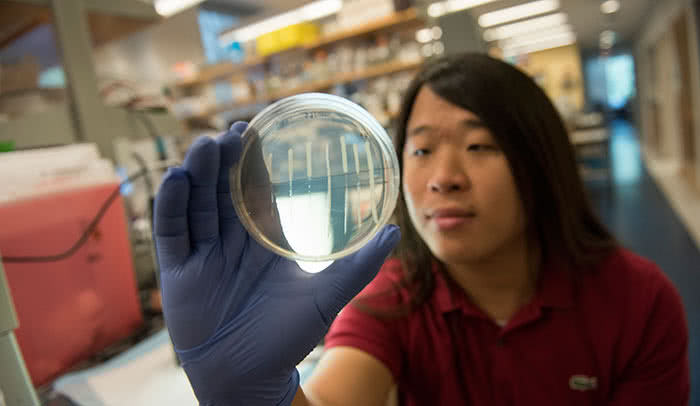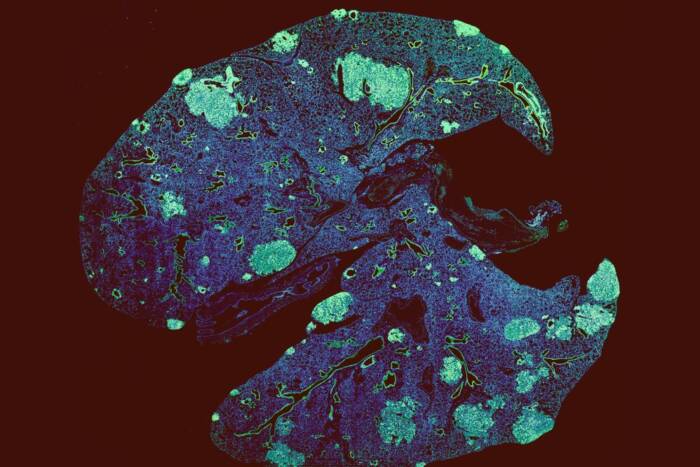Scientists uncover a clever ranking strategy bacteria use to fight off viruses

First and foremost: Jon McGinn, a graduate student in Luciano Marraffini’s lab, examined how the microbial immune system organizes its memories of viral assaults.
Like humans, bacteria come under attack from viruses and rely on an immune system to defend themselves. A bacterial immune system known as CRISPR helps microbes “remember” the viruses they encounter and more easily fend them off in the future. Since researchers first discovered CRISPR in the mid-2000s, they have noticed something peculiar: It records confrontations with viruses sequentially, placing the most recent attack first in a series of genetically encoded memories.
Now, two researchers at The Rockefeller University have explained why microbes store their immunological memories in this particular way. Their results were described September 8 in Molecular Cell.
“Until now, no one knew if this organizational feature serves a purpose, let alone what that might be,” says senior author Luciano Marraffini, an associate professor and head of the Laboratory of Bacteriology. “We found an answer: It allows the microbe to mount the strongest immune response against its most recent threat, which is likely to be the most potent one around.”
Microbial CRISPR systems remember viruses by capturing genetic snippets from them and storing them like beads on a string. (CRISPR stands for clustered regularly interspaced short palindromic repeats.) Should the cell meet a particular virus again, CRISPR-associated (Cas) enzymes use these snippets, known as spacers, to recognize and cut the virus. Thanks to this precision, one such system, CRISPR-Cas9, has become a powerful tool for editing genomes.
Researchers have wondered for some time why CRISPR systems create a chronological record of encounters with bacteria-attacking viruses known as phage.
Marraffini and first author Jon McGinn, a graduate student in the lab, determined that a small piece of the bacterial genome, which they called the leader anchoring sequence, is responsible for directing the most recent viral snippet to the first position within CRISPR. When this sequence was altered, CRISPR stopped adding new spacers to the front and began inserting them further downstream.
They found the bacteria with the misplaced spacers could still defend themselves against a low concentration of phage, but that the bugs were much more vulnerable at a high level of phage.
“An individual bacterium acquires a new spacer right when other infected cells in its surroundings are dying and releasing astronomical levels of new viral particles,” McGinn says. “We think this system ensures the cell can protect itself when the colony it lives in is inundated by phage.”
While this study helps scientists understand how CRISPR systems function within their native bacteria, it may also have implications for a new type of CRISPR-based biotechnology, one that is so far still the stuff of science fiction.
“Synthetic biologists have ambitions of creating biological recording devices that could store information using living cells. Technology like this could, for example, record a cell’s exposure to environmental stimuli or even the activity of brain cells” Marraffini says. “By acquiring sequential genetic memories of viral attacks, CRISPR already accomplishes a version of this, and our work helps to explain how this potential template works.”
This study was supported by the U.S. National Science Foundation, the Rita Allen Scholars Program, a Sinsheimer Foundation Award, and a NIH Director’s New Innovator Award (grant no. 1DP2AI104556-01)
 Molecular Cell 64, 1–8 Molecular Cell 64, 1–8CRISPR-Cas Systems Optimize Their Immune Response by Specifying the Site of Spacer Integration Jon McGinn and Luciano A. Marraffini |


